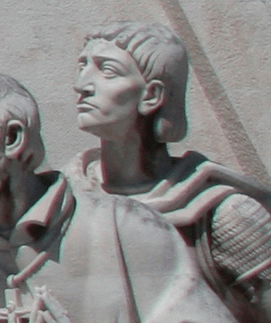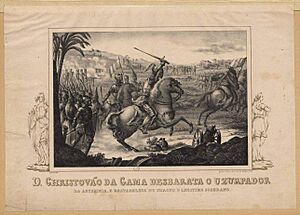Cristóvão da Gama facts for kids
Quick facts for kids
Cristóvão da Gama
|
|
|---|---|

|
|
| Born |
Cristóvão da Gama
c. 1516 |
| Died | August 29, 1542 (aged 25–26) Wofla, Adal Sultanate
|
| Nationality | Portuguese |
| Occupation | Military commander |
| Known for | Leader of a Portuguese military expedition in Ethiopia |
| Parent(s) | Vasco da Gama Catarina de Ataíde |
| Signature | |
 |
|
Cristóvão da Gama (born around 1516 – died August 29, 1542), also known as Christopher da Gama, was a brave Portuguese military leader. He commanded a group of 400 Portuguese soldiers. Their mission was to help Ethiopia fight against the Adal Sultanate, led by Imam Ahmad ibn Ibrahim al-Ghazi. This was a big conflict, sometimes called a holy war.
Cristóvão and his Ethiopian allies won four important battles against the Adal forces. However, in his last fight, the Battle of Wofla, he was badly hurt. He was captured, suffered greatly, and was then killed by Imam Ahmad. A famous writer, Richard Francis Burton, once called Gama "the most chivalrous soldier of a chivalrous age." This means he was seen as a very brave and honorable knight in a time when such qualities were highly valued.
Contents
Early Life and Adventures
Cristóvão da Gama was the son of the famous explorer Vasco da Gama. His older brother was Estêvão da Gama. Cristóvão first traveled to India in 1532 with his brother. He returned to Portugal in 1535.
Later, in 1538, he joined Garcia de Noronha on a journey to Diu. During these trips, Cristóvão often showed how clever he was. His quick thinking helped save his companions many times. Because of his skills, his brother Estêvão, who was then the Viceroy (a high-ranking governor) of India, gave him an important command. In 1541, Cristóvão led a ship in a fleet that sailed into the Red Sea. This fleet was fighting against the Ottoman navy at Suez. Unfortunately, Cristóvão and his brother were defeated in this battle.
The Ethiopian Campaign

After the defeat at Suez, Cristóvão and his brother returned to Massawa in May 1541. While there, Estêvão da Gama wanted to make the expedition worthwhile. He sent Cristóvão on a special mission to help the Emperor of Ethiopia, Gelawdewos. The Emperor's land was under attack.
Cristóvão led 400 Portuguese soldiers on this mission. Seventy of these men were also skilled builders or engineers. They brought about a thousand arquebuses (early guns), many pikes (long spears), and several bombards (large cannons). João Bermudes, who claimed to be the leader of the Ethiopian church, also joined them. A man named Miguel de Castanhoso, who was with Gama, later wrote down what happened during this campaign.
The Portuguese landed at Massawa and Arqiqo. They then began their journey inland to Debarwa. This was the capital of the Bahr negus, a local Ethiopian ruler.
Facing the Rainy Season
The Portuguese reached Debarwa after an eleven-day march on July 20. They soon learned that the rainy season (which they called "winter") made it impossible to travel further. Cristóvão did not want his men to be idle. He had them build sledges for the heavy cannons. They also raided nearby villages that had sided with the enemy leader, Ahmed Gragn.
Cristóvão also learned from the Bahr negus that Queen Seble Wongel was camped on a nearby mountain. Ahmed Gragn had not been able to capture her. Cristóvão took 100 men and marched to the mountain. He invited Queen Seble Wongel to join him. She came with her group of thirty men and fifty women. They were all welcomed with great respect.
First Battles
Once the rains ended, the Portuguese continued their journey south. Their heavy equipment slowed them down for months. So, Da Gama decided to leave half of it in a storage place on Debre Damo mountain. His army passed the Church of St. Romanos around Christmas 1541. They celebrated Epiphany in the province of Agame in January 1542.
Gama's first fight against the Imam's troops was on February 2, 1542. This was the Battle of Bacente. The enemy had taken over a hill and were raiding the countryside from there. Queen Seble Wongel advised Gama to go around the hill. She wanted him to wait for her son, Emperor Gelawdewos, to join them. But Gama believed that not fighting would make the local people lose trust in his soldiers. He feared they would stop bringing food and supplies. Luckily, the battle was a clear success. Gama's men captured the hill despite being outnumbered, losing only eight men.
Challenging the Imam
In late February, two Portuguese men arrived from a ship at Massawa. They were escorted by six local people. Gama sent 40 men to meet them, get supplies, and exchange news. This group did not reach the ship before it sailed away. This meant these soldiers were not present for the next big battle. This battle was against Ahmad Gragn himself.
As Queen Seble Wongel had feared, the fight at Bacente warned Ahmad Gragn that a hostile army was in the area. He marched north to face them. He met Gama at Jarte. The Imam sent a messenger to Gama. He demanded that the Portuguese either leave Ethiopia, join him, or be destroyed. The messenger also brought a monk's robe as a gift. This was a great insult to Gama.
Gama sent his own messenger back. He delivered a message in Arabic. It said he came to Ethiopia "by order of the great Lion of the Sea" (meaning the King of Portugal). He also said that the next day, Ahmad would see "what the Portuguese were worth." Gama also sent an insulting gift: a pair of small tweezers and a very large mirror. This was meant to suggest Ahmad was like a woman.
Two battles followed these exchanges at Jarte. The first was on April 4, and the next on April 16. The first battle was a victory for the Portuguese. Ahmad Gragn was wounded, and his troops had to retreat. The Portuguese moved their camp closer to the enemy, which led to the second battle. This time, the Adal-Ottoman army was even more clearly defeated. According to Castanhoso, the victory would have been complete if they had just had 100 horses to chase the fleeing enemy.
Ahmad was forced to retreat further south. With luck against him, the local people now openly refused to give him supplies or soldiers. Gama marched after him to Lake Ashangi. On the advice of Queen Seble Wongel, he set up camp on a hill in Wofla as the rainy season began.
The Final Battle and Gama's Death
Late in the rainy season, a Jew (possibly from the Beta Israel community) approached Gama. He told him about a mountain stronghold that Ahmad Gragn's followers held weakly. This mountain was a major barrier between Gama's forces and Emperor Gelawdewos. Gama also learned that the mountain had many horses, which he badly needed. Gama quickly marched south with about 100 men and captured the mountain.
Leaving 30 men to bring the horses, Gama led his victorious men back to Wofla. There, he found Ahmad Gragn ready to attack the next morning. Gragn had received many more musketeers (early gunners) from South Arabia and the Ottomans. He had 2,900 musketeers, far more than Gama. Despite their bravery, the Portuguese were heavily defeated on August 28 at the Battle of Wofla. Only 170 men survived the attack. Gama, whose arm was broken by a bullet, was captured that night with 14 companions.
Cristóvão da Gama was brought to Ahmed Gragn's camp. The Imam took the tweezers Gama had sent him and began to pull out Gama's beard. Gama was pressured to convert to Islam. But he remained strong. Accounts from the time describe Gama's courage and death in a way that makes him seem like a saint. In the end, Ahmad Gragn cut off Gama's head and threw it into a nearby spring. People later said the spring's water gained a reputation for healing the sick.
Aftermath and Revenge
Ahmad Gragn believed that the remaining Portuguese were scattered and without their weapons. He thought the threat was over. So, he sent away most of his foreign musketeers. He then went to his camp at Derasge near Lake Tana.
However, over 120 Portuguese survivors had joined Queen Seble Wongel. She had found safety at the Mountain of the Jews. Ten days later, her son, Emperor Gelawdewos, arrived. They planned their next move. Using the weapons stored at Debre Damo, the Portuguese were able to rearm themselves. With their help, Gelawdewos was able to gather a new army. This army met Ahmad Gragn at Wayna Daga.
The Portuguese musketeers focused their fire on the Muslim musketeers, who had been key in the Wofla battle. They also aimed at Imam Ahmad himself. While the stories differ a little, most agree that Ahmad Gragn was killed by Cristóvão da Gama's men. This was to get revenge for their commander's death.
See also
 In Spanish: Cristóbal de Gama para niños
In Spanish: Cristóbal de Gama para niños

